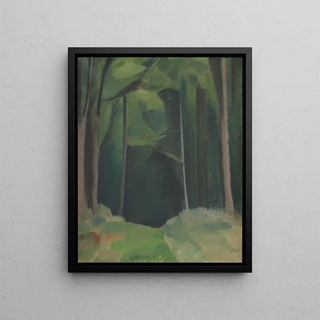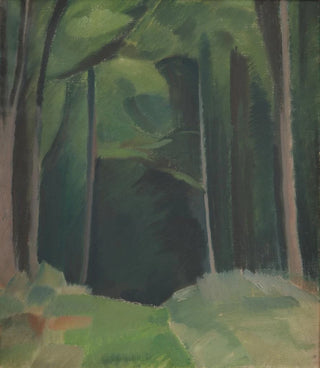Art print | Inside the wood - Harald Giersing


View from behind

Frame (optional)
Harald Giersing's artwork "Inside the Wood" is an invitation to explore a universe where nature and art intertwine with rare delicacy. This canvas, emblematic of the Danish modernist movement, evokes an atmosphere that is both peaceful and mysterious. By contemplating this piece, the viewer is transported to a space where light plays with shapes, revealing shades of color that seem to vibrate to the rhythm of a silent melody. The depiction of a wooded landscape, imbued with serenity, encourages reflection on our relationship with nature while offering a moment of contemplative escape.
Style and uniqueness of the artwork
Giersing's style is characterized by a unique approach to color and light. In "Inside the Wood," the artist employs earthy tones and vibrant touches to create a striking contrast between shadows and highlights. The stylized silhouettes of the trees appear to dance in the breeze, while the ground, covered with leaves, suggests a rich and lively texture. This piece stands out for its ability to capture the very essence of nature, while incorporating abstract elements that reflect the influence of cubism on his work. Giersing thus manages to transcend mere representation, offering an immersive visual experience that invites contemplation and daydreaming.
The artist and his influence
Harald Giersing, a major figure of Danish modernism, made his mark through his innovative approach to painting. Trained at the Royal Danish Academy of Fine Arts in Copenhagen, he was influenced by various artistic movements, ranging from Fauvism to Cubism. Giersing also traveled across Europe, absorbing the cultures and landscapes he encountered, which enriched his artistic vocabulary. His work is distinguished by a constant search for harmony between forms and colors, as well as a desire to depict nature in a new light. By incorporating elements of his immediate environment, Giersing succeeds in creating a strong emotional connection with the viewer, making each painting a window open to

Matte finish

View from behind

Frame (optional)
Harald Giersing's artwork "Inside the Wood" is an invitation to explore a universe where nature and art intertwine with rare delicacy. This canvas, emblematic of the Danish modernist movement, evokes an atmosphere that is both peaceful and mysterious. By contemplating this piece, the viewer is transported to a space where light plays with shapes, revealing shades of color that seem to vibrate to the rhythm of a silent melody. The depiction of a wooded landscape, imbued with serenity, encourages reflection on our relationship with nature while offering a moment of contemplative escape.
Style and uniqueness of the artwork
Giersing's style is characterized by a unique approach to color and light. In "Inside the Wood," the artist employs earthy tones and vibrant touches to create a striking contrast between shadows and highlights. The stylized silhouettes of the trees appear to dance in the breeze, while the ground, covered with leaves, suggests a rich and lively texture. This piece stands out for its ability to capture the very essence of nature, while incorporating abstract elements that reflect the influence of cubism on his work. Giersing thus manages to transcend mere representation, offering an immersive visual experience that invites contemplation and daydreaming.
The artist and his influence
Harald Giersing, a major figure of Danish modernism, made his mark through his innovative approach to painting. Trained at the Royal Danish Academy of Fine Arts in Copenhagen, he was influenced by various artistic movements, ranging from Fauvism to Cubism. Giersing also traveled across Europe, absorbing the cultures and landscapes he encountered, which enriched his artistic vocabulary. His work is distinguished by a constant search for harmony between forms and colors, as well as a desire to depict nature in a new light. By incorporating elements of his immediate environment, Giersing succeeds in creating a strong emotional connection with the viewer, making each painting a window open to






